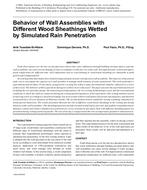Description
Field observations over the last two decades have shown that water infiltration through building envelope defects and into wall assemblies can cause serious damage if water accumulates within the core of the wall. If at high moisture content and appropriate temperature for sufficient time, wall components such as wood framing or wood-based sheathing are vulnerable to mold growth and biodegradation.
Several hygrothermal studies have looked at large amounts of water introduced in wall assemblies. The objective of the present study was to investigate the capacity of a wall assembly to manage small amounts of water penetration. The work performed is experimental and includes 19 specimens, grouped into a testing hut within a large environmental chamber, subjected to a series of three tests. The behavior of three specimens during two of these tests is discussed. The paper presents the experimental protocol including the test specimen design, the monitoring instrumentation, the two wetting methodologies used, and the environmental conditions to which the walls are subjected during the wetting and drying phases of the experiment. One wetting method consists of injecting water according to a measured leakage rate in an actual window/wall failure and actual rain frequency and duration extracted from a 20-year database of Montreal weather. The second method involves uniformly wetting a framing component by initial partial immersion. The results presented illustrate the role of different wood-based sheathings in the wetting and drying behavior of the wall assemblies. The sheathing materials include oriented strand board, plywood, and asphalt-coated fiberboard. Moisture content and relative humidity measurements for series of identical specimens built with different sheathing panels are presented during wetting and drying modes. The rate of drying is compared and the role of temperature gradient is demonstrated.
Citation: Thermal Performance of Exterior Envelopes of Whole Buildings IX
Product Details
- Published:
- 2004
- Number of Pages:
- 15
- File Size:
- 1 file , 6 MB
- Product Code(s):
- D-BldgsIX58




